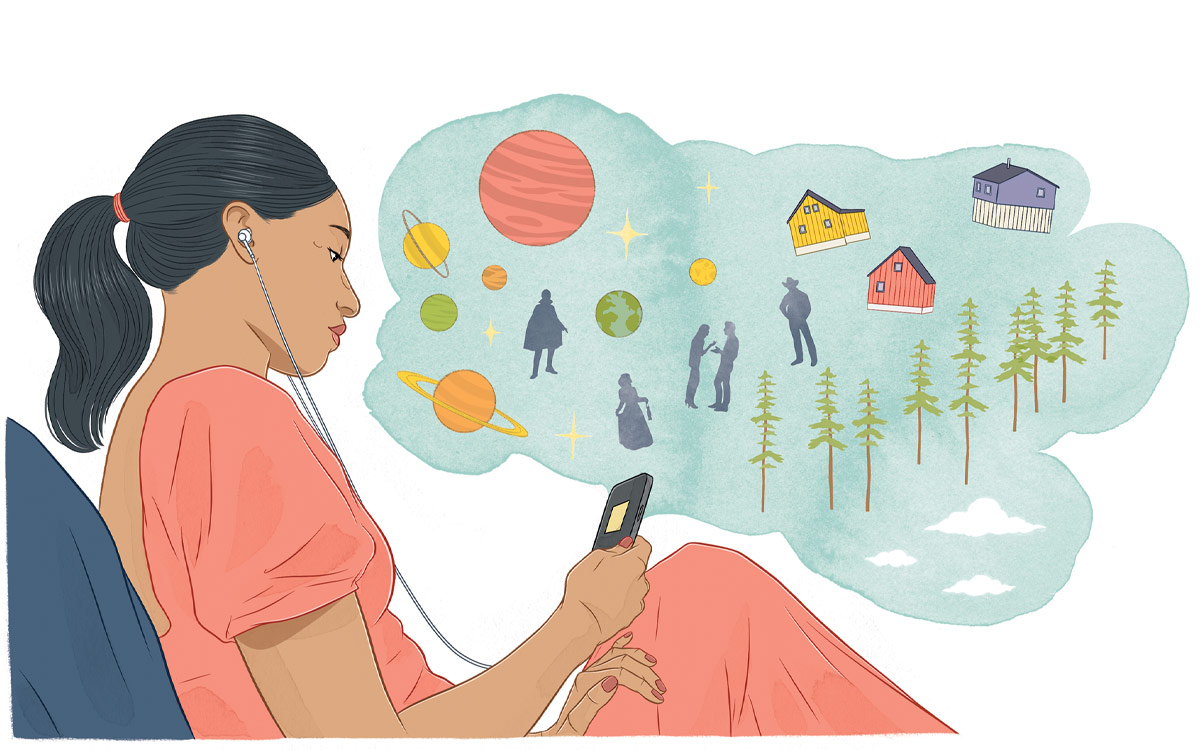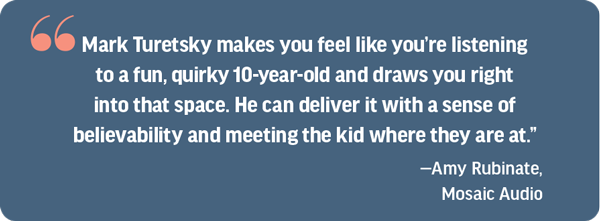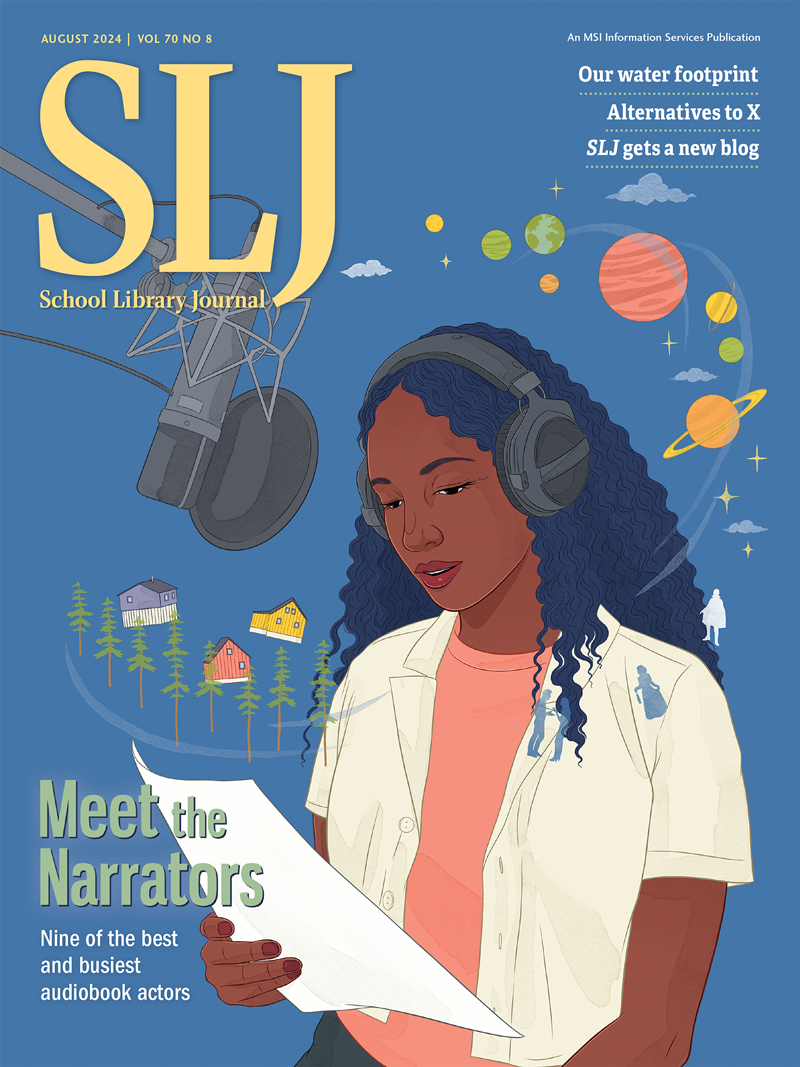Making a Great Audiobook: Librarians, Audio Experts on Elements of Outstanding Recordings
Music and sound effects can elevate an audiobook, but an authentic narrator is what makes for a stellar listening experience, librarians and industry experts say.
 |
Illustration by Stephanie Singleton |
Related readingThe Audiobook Wow Factor: What Nine Stellar Voice Actors Bring to the Mic |
Turning a book into an audiobook may seem like it wouldn’t be difficult. All you need is a story and a microphone…right?
Not exactly. Making a great audiobook is no easy feat. It starts with identifying the ideal narrator.
“Finding the right voice and someone who connects with the work and understands the intent is one of the biggest things,” says John Pels, editor and associate producer for Scholastic Audiobooks. “You can have a great book—but flat reading, all the bells and whistles aren’t going to save it.”
Amy Rubinate, owner of the award-winning audiobook studio Mosaic Audio, agrees.
“Casting is number one. If you don’t get the casting right, it’s hard to get the rest right,” she says. There needs to be a great actor who can also capture the spirit of the book.
Most anyone can read a book out loud, but there’s an art to being a superb narrator, like the beloved Jim Dale (of the “Harry Potter” audiobooks) or the acclaimed Bahni Turpin ( The Hate U Give and many more).
“A narrator can make or break an audiobook,” agrees Sarah Bean Thompson, youth services manager at Springfield-Greene County (MO) Library. “I think it’s when the narrator can make the story full of action and adventure and it feels fun.”
First, narrators must read at a good pace to keep kids engaged. “I frequently have to speed the narration up to 2x or even 3x when the narration is sleep-inducing,” says one media director.
Narrators also must find a way to match the voice of a character, without slipping into potentially offensive accents or adopting a monotonous tone.
Louisville (CO) Public Library’s teen services librarian Jessica Schwartz says some audiobooks her young readers love the most are “books with a dynamic performer who is perfectly matched to the story.” Those include Jonathan Stroud’s The Screaming Staircase, read by Miranda Raison; Sarwat Chadda’s City of the Plague God, read by Vikas Adam; and Jason Reynolds’s books, narrated by voice actors including his best friend, Guy Lockard.

Rubinate says voice actor Mark Turetsky is another example of someone with a special ability. “He makes you feel like you’re listening to a fun, quirky 10-year-old and draws you right into that space,” she says of Turetsky, whose recordings include Tom Angleberger’s “Origami Yoda” series and “The Candymakers” series by Wendy Mass. Rubinate adds, “He can deliver it with a sense of believability and meeting the kid where they are at.”
Music and sound effects can also elevate an audiobook, but those extras need to be authentic to the story. “Bells and whistles like a full cast performance, music, and sound effects usually add to appeal, but they can distract, too, especially if they aren’t mixed well,” says Schwartz.
It can be tempting to throw in sound effects with children’s audio, but doing too much risks turning a book into a cartoon, “muddying the recording and losing the integrity of the book,” Pels says.
Where sound effects have found their perfect use is bringing graphic novels to audio life. Recent audiobook versions of the graphic novels Invisible by Christina Diaz Gonzalez and Hey, Kiddo by Jarrett J. Krosoczka illustrate how art can be conveyed through sound to truly recreate the visual experience in audio format.
Pels, who produced the Invisible audiobook, also points to the audio version of “Captain Underpants” as another example of how sound effects can be used to create an exciting listening experience for kids. For that recording, his team used music and sound to delineate between the main stories and the short comic-book sections featured in the print books.
“When you’re reading, you go, ‘Oh, here’s the comic section,’ and then you go back to the story, so by setting it apart with more production, you get the feel of dipping out of the main story for something fun and then coming back into the main narrative,” Pels says.
Audio producers say that the recording is a surprisingly speedy process, so it’s important to get things right the first time. One way authors can help with this is providing pronunciation of characters and places. That’s especially helpful for, say, getting the name of a dragon right in a fantasy book.
And while most of the success of an audiobook comes from what the listener hears, what goes unheard can be just as important. “Getting a clear recording is challenging,” Pels says, and it takes a careful audio engineer to pick up on any little errors that could ruin the listening experience, from a stray breath to a stomach growl, a loud page turn, or a “pop” in the microphone.
So how do outstanding voice actors work their magic? Read on to learn about what sets nine top-notch narrators apart.
Andrew Bauld is a freelance writer covering education.

Cover illustration by Stephanie Singleton
RELATED
The job outlook in 2030: Librarians will be in demand
The job outlook in 2030: Librarians will be in demand
ALREADY A SUBSCRIBER? LOG IN
We are currently offering this content for free. Sign up now to activate your personal profile, where you can save articles for future viewing






Add Comment :-
Be the first reader to comment.
Comment Policy:
Comment should not be empty !!!